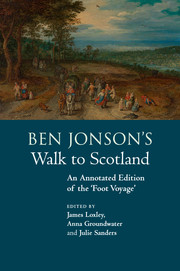Book contents
- Frontmatter
- Contents
- List of illustrations
- Acknowledgements
- A note on names
- Abbreviations
- Introduction: Jonson’s ‘Foot Voyage’ and the Aldersey manuscript
- My gossip Jonson his Foot Voyage and mine into Scotland
- Contextual essays
- 1 The genres of a walk
- 2 Jonson’s foot work
- 3 Scenes of hospitality
- Printed Works cited
- Index
2 - Jonson’s foot work
from Contextual essays
Published online by Cambridge University Press: 05 December 2014
- Frontmatter
- Contents
- List of illustrations
- Acknowledgements
- A note on names
- Abbreviations
- Introduction: Jonson’s ‘Foot Voyage’ and the Aldersey manuscript
- My gossip Jonson his Foot Voyage and mine into Scotland
- Contextual essays
- 1 The genres of a walk
- 2 Jonson’s foot work
- 3 Scenes of hospitality
- Printed Works cited
- Index
Summary
The landscape and the way
‘A route’, Catherine Delano-Smith acutely notes, ‘is not a road, nor in itself a physical feature, but a direction, an imaginary line linking a point of departure with a destination. Only its description gives it tangible form in speech or gesture, writing or image.’ Jonson’s walk was a dynamic and active form of engagement with the landscape, giving it a narrative and linear form that is itself not necessarily identical with the shape of the ‘Foot Voyage’ account kept by his companion. To read the landscapes of the walk, and the route it traces through them, requires us to attend to what cultural geography describes as the ‘geographies of mobility’ and ‘choreographies of place’. Making sense of the walk might therefore require us to think not just of the wager journey and the royal progress but also of other narrative genres or motifs and performance practices through which its significance might be – might have been – determined. Prominent among these is the pilgrimage, a term adopted for themselves and their expeditions by Taylor and Lithgow, used of Coryate by some of those who penned commendatory verses for his 1611 Crudities, and which provided the umbrella under which Samuel Purchas gathered his expanding collections of travel narratives in the second and third decades of the seventeenth century. It is a term applied to Jonson’s own adventure both retrospectively by William Drummond (who is perhaps quoting his guest) and, during the journey, by the earl of Rutland. One might also evoke the troubadour tradition of household visitations and a life of performance on the road, the quest structure and adventuring motifs of romance, or pastoral traditions of arboreal sanctuary and escape to the provincial and the regional countryside. All of these ways of understanding the physical and imaginary landscapes through which Jonson and his companion travelled are capable of illuminating aspects of the story of the walk; also relevant, though, is the evocation of more prosaic, material and indeed constructed environments, not least the bricks and mortar of country estates or of inns and hostelries in market towns, and the deer parks, pales and working ‘taskscapes’ that defined much of the countryside.
- Type
- Chapter
- Information
- Ben Jonson's Walk to ScotlandAn Annotated Edition of the 'Foot Voyage', pp. 134 - 170Publisher: Cambridge University PressPrint publication year: 2014



